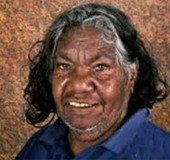Kathleen Petyarre
ABOUT:
Kathleen Petyarre (born 1940) is an eminent Australian Aboriginal artist, known for her paintings displaying an extremely refined layering technique with intricate dotting. Her art refers directly to her country and her Dreamings. However, the vastness of the country can be clearly felt in the landscapes of Petyarre’s paintings, which have occasionally been compared to the works of American Abstract Expressionists Jackson Pollock and Mark Rothko, and even to those of J.M.W. Turner. They have been described as: “magisterial works that can be likened to symphonic compositions” (Hood Museum of Art, Dartmouth College, New Hampshire, USA). Petyarre’s painstaking and virtuosic method of applying countless dots with kebab sticks of various sizes means she typically spends many days, sometimes weeks, on one canvas and has thus avoided the dangers of overproduction, widespread in Aboriginal art.
BACKGROUND:
Kathleen Petyarre was born at Atnangkere, an important water soakage for Aboriginal people on the western boundary of Utopia Station, 150 miles north-east of Alice Springs in Australia’s Northern Territory. She belongs to the Alyawarre/Eastern Anmatyerre clan and speaks Eastern Anmatyerre, with English as her second language. Kathleen, with her daughter Margaret and her sisters, settled at Iylenty (Mosquito Bore) at Utopia Station, near her birthplace. She started working in batik in 1977 when an adult education instructor, Jenny Green, arrived in Utopia and organised batik workshops. Kathleen Petyarre lives at Utopia Station to this day, but now also spends part of the year at her residence in Adelaide.
In 1996 she was the winner of the 13th Telstra National Aboriginal and Torres Strait Islander Art Award. Controversy arose in 1997 when Petyarre’s estranged partner of ten years, Ray Beamish, claimed that he had had a hand in the execution of the winning painting. This controversy, which shook the Aboriginal art market at the time, resulted in much stricter emphasis being put on the documentation of authorship in Aboriginal paintings. Her name was eventually cleared, and she retained her award.
Her considerable reputation as one of the most original indigenous artists has since been confirmed nationally and internationally by her regular inclusion in exhibitions at the most reputed museums and galleries. A book about her art, ‘ ‘Genius of Place’ ‘, was published in 2001 in conjunction with a solo exhibition of her works at the Museum of Contemporary Art in Sydney, and her paintings can be found in public and private collections all over the world. Her work has been selected, along with just a handful of Aboriginal artists, for inclusion in the permanent collection of the new Musée du quai Branly in Paris.
Awards
- 1996 Overall Winner of the Telstra 13th National Aboriginal & Torres Strait Islander Art Award, Darwin, NT, Australia.
- 1997 Overall Winner of the Visy Board Art Prize, the Barossa Vintage Festival Art Show, Nurioopta SA, Australia.
- 1998 Finalist, 1998 Seppelts Contemporary Art Award – Museum of Contemporary Art, Sydney, NSW Australia.
- 1998 Winner, People’s Choice Award, 1998 Seppelts Contemporary Art Award, Museum of Contemporary Art, Sydney, NSW, Australia.

